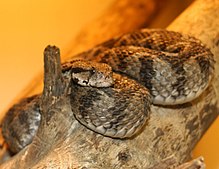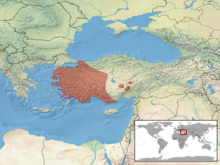
Russell's viper is a highly venomous snake in the family Viperidae native to the Indian subcontinent and one of the big four snakes in India. It was described in 1797 by George Shaw and Frederick Polydore Nodder, and named after Patrick Russell, who wrote about it in his 1796 work An account of Indian serpents, collected on the coast of Coromandel.

Bitis nasicornis is a viper species belonging to the genus Bitis, part of a subfamily known as "puff-adders", found in the forests of West and Central Africa. This large viper is known for its striking coloration and prominent nasal "horns". No subspecies are currently recognized. Its common names include butterfly viper, rhinoceros viper, river jack and many more. Like all other vipers, it is venomous.

The Caspian cobra, also called the Central Asian cobra or Russian cobra, is a species of highly venomous snake in the family Elapidae. The species is endemic to Central Asia. First described by Karl Eichwald, a German physician, in 1831, it was for many years considered to be a subspecies of the Naja naja until genetic analysis revealed it to be a distinct species.

Echis is a genus of vipers found in the dry regions of Africa, the Middle East, India, Sri Lanka and Pakistan. They have a characteristic threat display, rubbing sections of their body together to produce a "sizzling" warning sound. The name Echis is the Latin transliteration of the Greek word for "viper" (ἔχις). Like all vipers, they are venomous. Their common name is "saw-scaled vipers" and they include some of the species responsible for causing the most snakebite cases and deaths in the world. Twelve species are currently recognized.

Vipera is a genus of vipers. It has a very wide range, being found from North Africa to just within the Arctic Circle and from Great Britain to Pacific Asia. The Latin name vīpera is possibly derived from the Latin words vivus and pario, meaning "alive" and "bear" or "bring forth"; likely a reference to the fact that most vipers bear live young. Currently, 21 species are recognized. Like all other vipers, the members of this genus are venomous.

Vipera ammodytes, commonly known as horned viper, long-nosed viper, nose-horned viper, and sand viper, poskok is a species of viper found in southern Europe, mainly northern Italy, the Balkans, and parts of Asia Minor. Like all other vipers, it is venomous. It is reputed to be the most dangerous of the European vipers due to its large size, long fangs and high venom toxicity. The specific name, ammodytes, is derived from the Greek words ammos, meaning "sand", and dutes, meaning "burrower" or "diver", despite its preference for rocky habitats. Five subspecies are currently recognized, including the nominate subspecies described here.

Naja is a genus of venomous elapid snakes commonly known as cobras. Members of the genus Naja are the most widespread and the most widely recognized as "true" cobras. Various species occur in regions throughout Africa, Southwest Asia, South Asia, and Southeast Asia. Several other elapid species are also called "cobras", such as the king cobra and the rinkhals, but neither is a true cobra, in that they do not belong to the genus Naja, but instead each belong to monotypic genera Hemachatus and Ophiophagus.
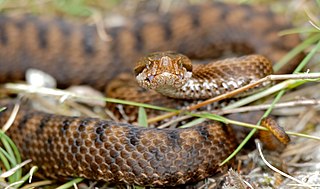
Vipera aspis is a viper species found in southwestern Europe. Its common names include asp, asp viper, European asp, and aspic viper, among others. Like all other vipers, it is venomous. Bites from this species can be more severe than from the European adder, V. berus; not only can they be very painful, but approximately 4% of all untreated bites are fatal. The specific epithet, aspis, is a Greek word that means "viper." Five subspecies are currently recognized, including the nominate subspecies described here.
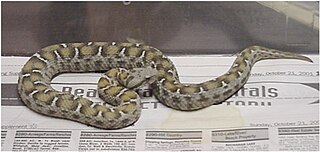
Montivipera albizona, the central Turkish mountain viper, is a viper species endemic to the mountainous regions of central Turkey. Like all other vipers, it is venomous. No subspecies are currently recognized.

The horned adder is a viper species. It is found in the arid region of southwest Africa, in Angola, Botswana, Namibia; South Africa, and Zimbabwe. It is easily distinguished by the presence of a single, large horn-like scale over each eye. No subspecies are currently recognized. Like all other vipers, it is venomous.
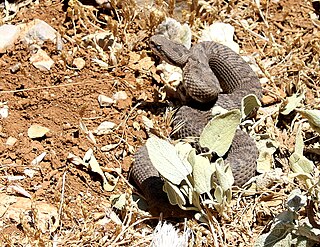
The Lebanon viper, also known as Bornmueller's viper, is a species of venomous snake in the subfamily Viperinae of the family Viperidae. The species is native to Western Asia. There are no recognized subspecies.

The Mount Bulgar viper, also called the Bulgardagh viper is a viper species endemic to the mountains of southern Turkey. Like all other vipers, it is venomous. No subspecies are currently recognized.
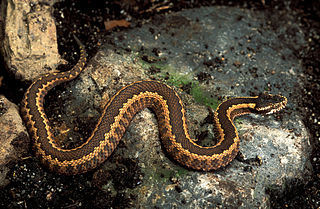
Vipera dinniki is a viper species native to the Caucasus Mountains region, part of Russia, Georgia, and Azerbaijan. Like all other vipers, it is venomous. No subspecies are currently recognized.

Montivipera latifii, known as Latifi's viper, the Iranian valley viper, or the Lar Valley viper, is a species of venomous snake in the subfamily Viperinae of the family Viperidae. The species is endemic to Iran. There are no subspecies that are recognized as being valid.

Vipera lotievi, commonly known as the Caucasian meadow viper, is a species of venomous snake in the family Viperidae. The species is endemic to Azerbaijan, Georgia, and Russia. There are no subspecies that are recognized as being valid.

Daboia palaestinae, also known as the Palestine viper, is a viper species endemic to the Levant. Like all vipers, it is venomous. It is considered a leading cause of snakebite within its range. No subspecies are currently recognized.

Montivipera raddei, also known as the Armenian viper and by many other common names, is a species of venomous snake in the subfamily Viperinae of the family Viperidae. The species is endemic to Armenia, Azerbaijan, Iran, Turkey, and possibly also Iraq. Two subspecies are currently recognized.

Vipera ursinii is a species of venomous snake in the subfamily Viperinae of the family Viperidae. It is a very rare species, which is in danger of extinction. This species is commonly called the meadow viper. It is found in France, Italy, and Greece as well as much of eastern Europe. Several subspecies are recognized. Beyond the highly threatened European population, poorly known populations exist as far to the east as Kazakhstan and northwestern China.

Wagner's viper, known as the ocellate mountain viper, ocellated mountain viper, and Wagner's viper, is a species of venomous snake in the subfamily Viperinae of the family Viperidae. The species is native to eastern Turkey and northwestern Iran. There are no subspecies that are recognized as being valid.
